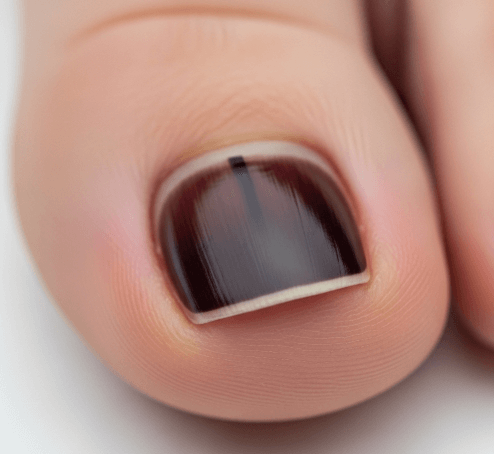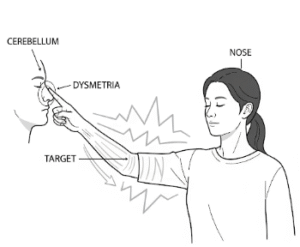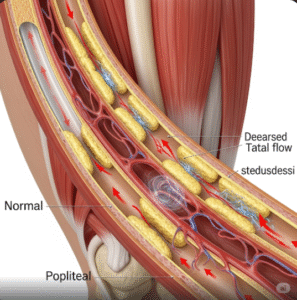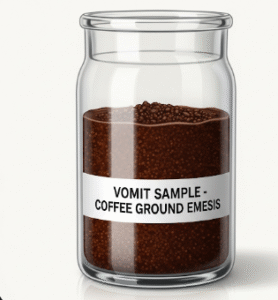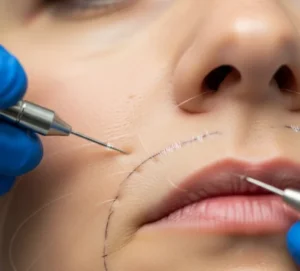What it is
→ Longitudinal melanonychia is a brown or black pigmented streak that runs lengthwise along the nail plate. This occurs when melanin (the pigment responsible for skin, hair, and nail color) is produced in excess in the nail matrix.
→ It may affect one nail or multiple nails. The streak can differ in width, color intensity, and regularity — sometimes uniform, sometimes irregular.
→ Causes include benign conditions such as ethnic or racial pigmentation, nail trauma, or medications, and also serious causes like melanoma (a type of nail cancer).
→ A longitudinal melanonychia check is a clinical evaluation to determine whether the streak is harmless or potentially malignant.
Why it’s done
→ The main purpose of this check is to differentiate between benign and malignant causes.
→ Many cases are harmless, but some may indicate subungual melanoma, a rare yet dangerous skin cancer under the nail.
→ Early detection can save lives, since melanoma has high cure rates when caught early.
→ Other reasons include:
- Identifying changes due to trauma, medication, or infections.
- Monitoring streaks for growth, color changes, or spreading.
- Relieving patient anxiety with an accurate diagnosis.
- Creating a baseline for future monitoring.
Alternatives
→ Self-checking or monitoring at home may be attempted, but it is not reliable, as melanoma can look similar to harmless streaks.
→ Alternatives include:
- Self-examination → watching for changes in streak width, color, or shape.
- Photographic monitoring → taking monthly nail photos to compare progression.
- General physician check → a primary care doctor may do an initial exam before referring to dermatology.
→ However, dermatologist-led checks remain the safest and most accurate.
Preparation
→ Preparing for the check is simple but important:
- Medical history → be ready to share family history of melanoma, personal skin cancer history, medications, and any nail trauma.
- Avoid nail polish → keep nails free of polish or artificial nails so the streak is fully visible.
- Observation notes → write down when the streak first appeared and if it has changed.
- Symptom diary → record pain, bleeding, splitting, or nail detachment if present.
- Bring photos → old nail photos help track changes.
How it’s Done
→ A dermatologist usually follows these steps:
- Visual inspection → checking streak width, borders, symmetry, and color.
- Dermoscopy → using a magnifying scope with light to analyze pigment patterns.
- ABCDEF rule → evaluating Age, Band width, Change, Digit involved, Extension of pigment, and Family history.
- Biopsy → if suspicious, a nail matrix or bed biopsy is performed under local anesthesia for lab analysis.
- Imaging → some clinics use ultrasound or confocal microscopy before biopsy.
- Documentation → photos and dermoscopy results are recorded for follow-up.
Recovery
→ Recovery depends on whether a biopsy is done.
- No biopsy → no downtime; patients return to daily activities immediately.
- With biopsy → healing may take 1–3 weeks.
- Mild pain and swelling are common for a few days.
- Patients may need to protect the nail and keep it bandaged.
- Antibiotic ointments are sometimes prescribed.
→ If melanoma is confirmed, recovery also includes adapting to additional treatment such as surgery or systemic therapy.
Complications
→ Risks from the check are generally low.
- Pain or swelling at the biopsy site.
- Nail deformity while the nail regrows.
- Infection if proper aftercare is not followed.
- Bleeding or hematoma after invasive checks.
- Permanent nail changes in rare cases of deep biopsies.
→ The bigger danger is not checking melanonychia. Late-diagnosed melanoma carries serious consequences.
Treatment options in Korea
→ Korea is known for advanced dermatology and oncology care, and melanonychia checks are widely available.
- Specialized hospitals such as Seoul National University Hospital and Asan Medical Center provide comprehensive nail cancer diagnostics.
- Dermoscopic checks are standard, with Korean dermatologists skilled in separating ethnic melanonychia (common in Asians) from melanoma.
- Minimally invasive biopsies reduce permanent nail damage while ensuring accurate diagnosis.
- Strong pathology labs in Korea are internationally recognized for precise melanoma analysis.
- Integrated treatment teams (dermatologists, oncologists, surgeons) collaborate if melanoma is confirmed.
- Aesthetic focus → Korea also emphasizes cosmetic nail recovery, offering nail reconstruction and camouflage techniques.
- Preventive approach → Korean clinics encourage early checks, especially for high-risk groups.
→ Many hospitals also provide long-term monitoring programs, where patients return regularly for nail imaging and documentation.

